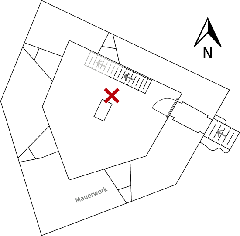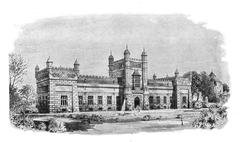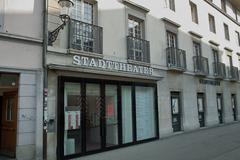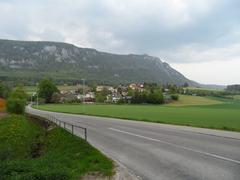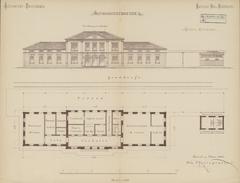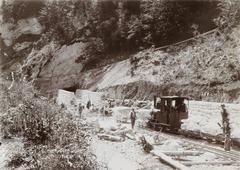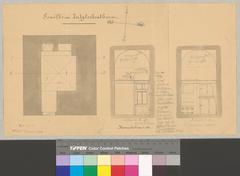University Of Applied Sciences Northwestern Switzerland
University of Applied Sciences Northwestern Switzerland Solothurn: Visiting Hours, Tickets, and Historical Significance
Date: 14/06/2025
Introduction
The University of Applied Sciences Northwestern Switzerland (FHNW) Solothurn campus is a distinguished institution situated in the heart of Solothurn, one of Switzerland’s most picturesque Baroque cities. Marrying innovative applied sciences education with the rich cultural and architectural heritage of Solothurn, the campus provides a compelling destination for students, researchers, and travelers. Visitors to FHNW Solothurn not only discover Switzerland’s dynamic higher education system but also experience the city’s vibrant culture, historic landmarks, and stunning natural scenery.
Solothurn is widely regarded as Switzerland’s most beautiful Baroque town. Its well-preserved old town features elegant palaces, churches, and cobblestone streets that blend Italian, French, and German architectural influences. Landmarks such as St. Ursus Cathedral, the Jesuit Church, and the medieval Basel Gate offer insights into centuries of history. Nearby natural sites, including Weissenstein Mountain and Verena Gorge, provide additional opportunities for exploration.
FHNW Solothurn welcomes visitors with organized facilities, free campus and library access, wheelchair accessibility, and guided tours that showcase its academic programs and research. Public events and exhibitions foster community engagement. Convenient public transportation and the campus’s central location, close to Solothurn’s old town, make it easily accessible.
This guide provides an in-depth overview of FHNW Solothurn’s history, significance, visitor information (including opening hours and ticketing), as well as recommendations for nearby attractions and practical travel tips. For up-to-date details, consult the official FHNW website and the Solothurn Tourism Portal.
Contents
- Introduction
- History and Significance of FHNW Solothurn Campus
- Role in Swiss Higher Education
- Academic Programs and Research
- Visiting the FHNW Solothurn Campus
- Visiting Hours and Ticketing
- Accessibility and Facilities
- Guided Tours and Public Events
- Nearby Attractions and Cultural Highlights
- Solothurn Old Town and Baroque Architecture
- St. Ursus Cathedral
- Museums and Cultural Venues
- Natural Sites and Outdoor Activities
- Travel Tips and Visitor Information
- Transportation and Accessibility
- Language and Currency
- Accommodation and Local Cuisine
- Frequently Asked Questions (FAQs)
- Conclusion
FHNW Solothurn Campus: Visitor Information, Tours, and Local Attractions
Why Visit FHNW Solothurn?
The FHNW Solothurn campus offers a unique intersection of modern academic achievement and regional heritage. Located in Solothurn’s historic center, the campus is a magnet for prospective students, academic visitors, and cultural tourists.
Whether interested in Switzerland’s approach to applied sciences, seeking academic collaboration, or simply exploring the city’s culture, visitors benefit from a welcoming atmosphere and a range of engaging activities.
Visiting Hours, Ticketing, and Accessibility
- Opening Hours: Monday to Friday, 8:00 AM to 6:00 PM (hours may vary during holidays or special events; always check the FHNW website for updates).
- Ticketing: Admission to the campus and library is free. Most public events do not require tickets; however, special workshops or exhibitions may have entrance fees, which can be purchased online or at the information center.
- Accessibility: The campus is fully wheelchair accessible, with modern amenities to ensure all visitors’ comfort.
Guided Tours and Public Events
- Guided Tours: Available by prior arrangement through the campus visitor center. These tours offer insights into FHNW’s academic offerings, research, and history.
- Public Events: Regularly scheduled lectures, exhibitions, and forums (such as MasterForum and GeoForum) are open to the public, providing opportunities to engage with faculty, students, and local experts.
Facilities for Visitors
- Library: Located at Bahnhofstrasse 6, open to both students and the general public, providing access to extensive academic resources.
- Transportation: The campus is easily reached by train, bus, bike, or on foot. Bike racks and cycling routes promote sustainable travel.
History and Academic Significance
Institutional Role
FHNW is among Switzerland’s leading universities of applied sciences, recognized for practice-oriented teaching and research. The Solothurn campus plays a crucial role in connecting academic theory to professional practice, with programs integrating internships, project-based learning, and partnerships with local industries.
Academic Programs and Research
The campus offers degrees in fields such as engineering, liberal arts, business, mathematics, psychology, and art & design. FHNW Solothurn is part of a strong network of international collaborations and student exchange programs, further enhancing its academic environment.
Solothurn’s Baroque Heritage and Main Attractions
Baroque Old Town
Solothurn’s old town is a pedestrian-friendly area characterized by cobblestone streets, Baroque palaces, and vibrant squares. The city’s architectural marvels reflect centuries of cultural exchange and prosperity (switzerland-tour.com).
St. Ursus Cathedral
A masterpiece of Swiss Baroque, St. Ursus Cathedral was built between 1762 and 1773 and is dedicated to the city’s patron saint. Highlights include:
-
Interior: Lavish ceiling frescoes, marble columns, and ornate altars.
-
Organ: One of Switzerland’s largest, hosting regular concerts.
-
Tower: Offers panoramic views of Solothurn and the Jura Mountains (tower entry: CHF 5, 249 steps).
-
Opening Hours: Daily, 9:00 AM–5:00 PM (tower hours may vary).
-
Tickets: Free entry; small fee for tower access.
-
Accessibility: Cathedral is wheelchair accessible; tower is not.
(St. Ursus Cathedral official page)
Other Landmarks
- Jesuit Church: Renowned for its stucco work and frescoes; open Monday–Saturday, 10:00 AM–4:00 PM, free entry.
- Baseltor (Basel Gate): 16th-century city gate marking the old town entrance.
- Waldegg Castle: Baroque residence with gardens; open April–October, Tuesday–Sunday, 11:00 AM–5:00 PM. Tickets: CHF 10 adults, CHF 5 children.
Museums and Cultural Venues
- Alte Zeughaus (Old Arsenal): Arms and armor collections (triplyzer.com).
- Natural History Museum: Local flora, fauna, and geology.
- ENTER Museum: Swiss computing and technology history (switzerland-tour.com).
Natural Sites
- Weissenstein Mountain: Accessible by cable car for hiking and panoramic views.
- Verena Gorge: Tranquil walking trails and a hermitage (swissactivities.com).
- Aare River: Popular for swimming, canoeing, and riverside strolls.
Travel Tips and Practical Information
- Getting There: Solothurn is well connected by train; the campus and old town are a short walk from the station (bls.ch).
- Getting Around: The city center is compact and best explored on foot; limited parking, so public transport is recommended.
- Language and Currency: German is the primary language, but English is widely spoken in tourism and academic settings. Currency is Swiss Franc (CHF).
- Accommodation: Choices range from boutique hotels in historic buildings to modern guesthouses. The Landhaus is a popular central option.
- Local Cuisine: Don’t miss Solothurner Torte (almond-hazelnut cake) at a riverside café.
- Best Visiting Time: Late spring to early autumn, especially June, for pleasant weather and festivals (globalhighlights.com).
- Customs: Shops may close for lunch and on Sundays.
Frequently Asked Questions (FAQs)
Q: What are the FHNW Solothurn campus visiting hours?
A: Monday to Friday, 8:00 AM–6:00 PM. Special event hours may vary; check the FHNW website for updates.
Q: Do I need a ticket to visit the campus or library?
A: No, admission is free; some special events may require tickets.
Q: How can I book a guided tour?
A: Contact the visitor center or book through the FHNW website.
Q: Is the campus accessible for people with disabilities?
A: Yes, all facilities are wheelchair accessible.
Q: What cultural sites are nearby?
A: St. Ursus Cathedral, Jesuit Church, Baseltor, Waldegg Castle, and several museums are within walking distance.
Q: What is the best way to reach Solothurn?
A: By train; the city is well connected to Bern, Basel, and Zurich.
Enhance Your Visit
- Plan Ahead: Check FHNW’s events calendar and the Solothurn Tourism Portal for the latest information and events.
- Audiala App: Download for interactive guides, audio tours, and travel tips.
- Explore Further: Walk the old town, enjoy riverside cafés, and take in panoramic views from the cathedral tower or Weissenstein Mountain.
- Photography: Capture the blend of modern campus design against Solothurn’s Baroque backdrop for unforgettable memories.
Conclusion
Visiting the University of Applied Sciences Northwestern Switzerland Solothurn campus offers a unique opportunity to experience Swiss academic innovation in a city celebrated for its Baroque beauty and cultural vitality. The campus’s open-access policy, excellent visitor amenities, and integration within Solothurn’s historic landscape make it inviting for a diverse audience—from academics and students to tourists and culture enthusiasts.
Solothurn’s rich history, vibrant festivals, and natural surroundings, paired with the university’s dynamic academic environment, create a harmonious blend of tradition and innovation. Whether you’re planning an academic visit or a leisurely cultural tour, FHNW Solothurn and its surroundings promise a memorable experience.
For the most current information, visit the FHNW Official Website and the Solothurn Tourism Portal.
Sources
- Visiting the FHNW Solothurn Campus: Hours, Tours, and Nearby Attractions for Tourists, 2024, FHNW Tourism Guide (https://www.fhnw.ch/de)
- FHNW Solothurn Campus: Visiting Hours, Tickets & Cultural Highlights in Solothurn, 2024, FHNW Official Communications (https://www.fhnw.ch/en)
- Visiting St. Ursus Cathedral in Solothurn: Hours, Tickets, and Historical Insights, 2024, Solothurn City Tourism (https://www.solothurn-city.ch/en/discover-solothurn/attractions/st-ursus-cathedral)
- Solothurn Baroque Jewel: Visiting Hours, Tickets & Historical Sites Guide, 2024, Switzerland Travel and Culture (https://switzerland-tour.com/destinations/solothurn)

